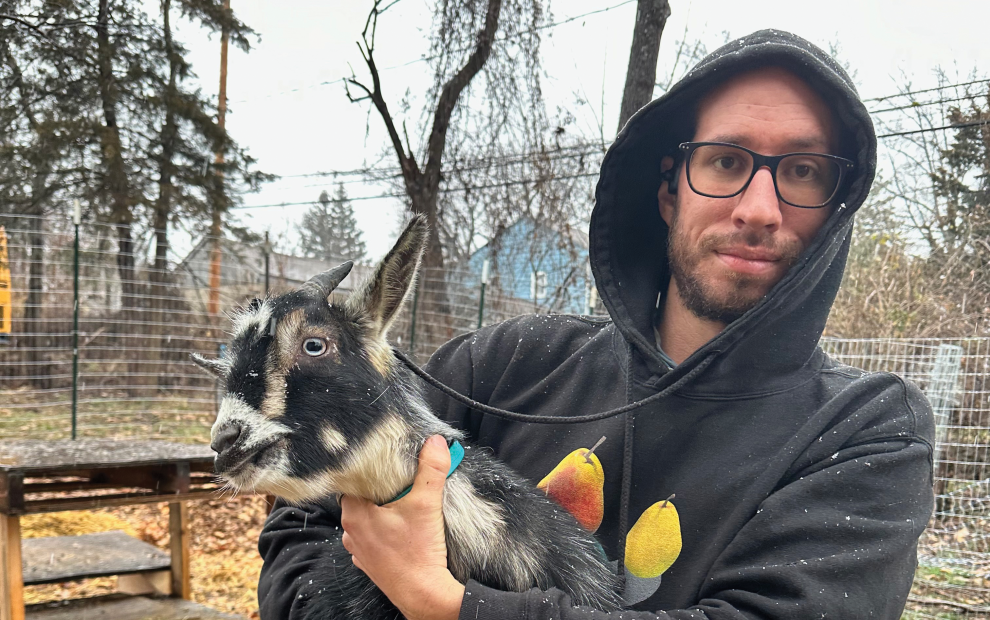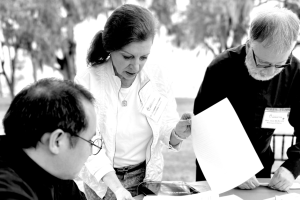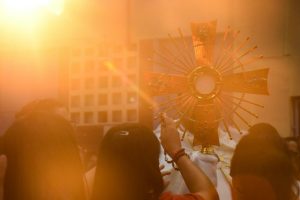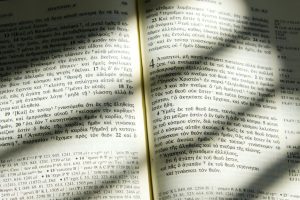Servant of God Dorothy Day said, “Don’t call me a saint. I don’t want to be dismissed that easily,” referencing her cofounding of the Catholic Worker movement and her life dedicated to social justice, nonviolence, hospitality, and solidarity with the poor. She didn’t want people to think what she was doing was unachievable by an everyday Catholic.
Spencer Hess feels the same. Hess founded the JPII Catholic Worker Farm, an urban organic farm in Kansas City, Missouri, and the Maurin Academy for Regenerative Studies, a self-described “21st-century agronomic university.”
“There’s a tendency to imagine that what we’re doing is so radical and extreme,” he says, “but it’s not this freakish, heroic, saintly activity. [What we’re doing] is actually part of the universal call to holiness.”
Hess and his wife, Emily, put the Catholic Worker principles of simplicity, shared labor, sustainability, and environmental care into action by practicing organic gardening and homesteading. In addition to growing things like garlic, onions, tomatoes, and leafy greens, the couple cares for a small orchard and manages a multitude of chickens, goats, sheep, and bees. In accordance with the Catholic Worker ethos, the JPII Catholic Worker Farm is immersed in long-term intimate hospitality, with a handful of folks living and working with them on the farm.
Most of what they grow or produce they try to give away, working with their neighbors to establish and maintain a sturdier local food system—and build community in the process. They also sell a small amount of their crops, and they put a strong emphasis on composting, ensuring they are “respecting natural limits and working in tune with natural patterns, not breaking them,” Hess says.
“What we functionally have—at a small scale—is a closed loop system where we’re being responsible for our food waste and for our land,” he says. “You can come to this farm and see the circle of life, from fallen tree limbs to animals to the garden.” This is how Hess believes the gospel calls us to live.
“We want total fulfillment in our lives, and ultimately, that has to be found in God, but that can also be found mediated in all sorts of aspects of our life,” he says. “Farming is a specific place to do that because it is so integrated in nature.”
“There’s a tendency to imagine that what we’re doing is radical, but it’s not this saintly activity.”
Advertisement
Born and raised in a rural Dodge City community in western Kansas, Hess became interested in organic farming in his early adulthood; he studied horticulture at Kansas State University and became president of the school’s farm club. Food, for Hess, “seemed like a radical, fundamental aspect of human life,” and he was convinced that “the corporate industrial agriculture system wasn’t ideal for people or for the planet.”
This belief led Hess to spend a year after college WWOOFing (World Wide Opportunities on Organic Farms) in the South to seek an alternative way of authentically growing food and living in community. When he returned to Kansas City, he began a farming cooperative project, which, unfortunately, never materialized in the way Hess had imagined. But his desire to chart a different kind of path for himself—and society—remained.
When he was a young adult, on what Hess describes as “parallel but distinct” paths, he also became interested in Christian theology and, more specifically, Catholic social teaching—which, he says, “are basically calling for a radical transformation of our lives and how we treat other human beings and the Earth; to evaluate every aspect of our lives and transform it in the light of Christ.”
Catholic social teaching ultimately served as the backbone of Hess’ conversion to Catholicism, after which he knew he wanted to pursue urban agriculture through its lens and intentionally live out his faith through organic farming. His previous farming cooperative was reimagined as the JPII Catholic Worker Farm, aptly named after Catholic social teaching champion St. Pope John Paul II.
Growing organic food and using it to build community was important, but being a Catholic Worker farm was paramount for Hess. “Ultimately, if you don’t have some sort of robust conception of theology and what human people are, it’s very hard to maintain these things over the long run,” he says. “I think part of what it takes to maintain them is a robust faith in something other than the goodness of human beings and nature.”
Hess’ discovery of the Catholic Worker Movement—which happened in tandem with both his conversion and his call to organic farming—came about through the ideas of social activist Peter Maurin, Day’s cofounder of the movement. What most intrigued Hess was Maurin’s idea that our lives should be centered on what he described as the “three C’s: cult, culture, and cultivation,” sometimes defined as “liturgy, literature, and agriculture.”
These ideas inspired Hess to create a farm book club in college that evolved into the Maurin Academy for Regenerative Studies, a nonprofit where Hess, along with his wife, Emily, and Maurin Academy cofounder Laurie M. Johnson (who is also professor of political science at Kansas State) can practice agriculture while learning about and discussing life, culture, science, and religion. Their website states that they “strive to synthesize theological, philosophical, and ecological insights in order to generate a renewed and healthier future without losing sight of the concrete dilemmas of everyday life.”
“What we’re trying to explore more at the intellectual level is the three C’s—these three domains—how they intersect and how they also maintain their distinctness,” Hess says. “Also [we’re] trying to understand how Catholic theology integrates with Catholic social teaching and how we should be living our lives.”
The Maurin Academy does this by offering classes, reading groups, and events, in addition to putting out their regular Dustbowl Diatribes podcast and content through Johnson’s Political Philosophy Channel on YouTube. It’s a way for Hess to intellectually make sense of his life, his faith, and the world around him.
While the farm and the Maurin Academy continue to grow beyond their early beginnings, Hess seeks to continue authentically living out his Catholic faith and Catholic social teaching in a way that is realistic, attainable, and in service of the Earth.
“A eucharistic vision of the world means that everything is, to some extent, participating in God’s nature,” he says. “We have to ask ourselves, ‘Are we degrading what exists? Or are we not?’ ”
Quick takes:
What is your favorite thing to grow on your farm?
I have a lot of front runners, but probably peas because they’re very beautiful plants. They’re easy to grow, taste good, and are beautiful.
What idea from Peter Maurin resonates most with you?
Something Maurin said periodically was “at personal cost,” and it was in the context that people should be practicing the works of mercy and carrying out the Catholic Worker program at personal cost. Part of his condemnation of modern society is that nobody wanted to pay at personal cost. They wanted some sort of scheme to get other people to pay to do the type of work they wanted to do.
What passage from scripture speaks most to you?
Luke 5:19. I especially love the image from the story of the paralyzed man getting lowered down from the roof. In at least one of the gospels, Christ says that there’s a collective faith. He’s acknowledging not just the faith of the person who’s been healed but the faith of the people lowering the paralyzed man down. I think that’s one of the best images—a sinner who’s literally unable to move being healed. The line from Luke 5:19 is, “I say to you, take up your mat and walk.” I like that.
This article also appears in the February 2025 issue of U.S. Catholic (Vol. 90, No. 2, pages 45-46). Click here to subscribe to the magazine.
Image: Courtesy of Spencer Hess












Add comment